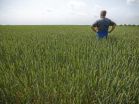(Press-News.org) AMES, Iowa – Certain bonds connecting biological cells get stronger when they're tugged. Those bonds could help keep hearts together and pumping; breakdowns of those bonds could help cancer cells break away and spread.
Those bonds are known as catch bonds and they're formed by common adhesion proteins called cadherins. Sanjeevi Sivasankar, an Iowa State University assistant professor of physics and astronomy and an associate of the U.S. Department of Energy's Ames Laboratory, has described catch bonds as "nanoscale seatbelts. They become stronger when pulled."
But how does that happen? How can bonds get stronger under force?
Sivasankar and his research team have found long-lived, force-induced hydrogen bonds are the answer. A paper describing their findings, "Resolving the molecular mechanism of cadherin catch bond formation," has just been published online by Nature Communications.
Sivasankar is the corresponding author. Co-authors are Kristine Manibog, an Iowa State graduate student in physics and astronomy and a student associate of the Ames Laboratory; Hui Li, of the Suzhou Institute of Biomedical Engineering and Technology of the Chinese Academy of Sciences in Suzhou New District, China; and Sabyasachi Rakshit, of the Indian Institute of Science Education and Research in Mohali, India. Li and Rakshit are former postdoctoral researchers in Sivasankar's laboratory.
The team's research was supported by grants from the American Cancer Society and the American Heart Association.
Sivasankar said strong cell-to-cell bonds are important to heart health and fighting cancer. He said the bonds connecting heart cells have to withstand constant mechanical forces. And, in some cancers, he said bonds no longer resist forces, allowing cancer cells to detach and spread.
To find the mechanism behind the strong ties created by catch bonds, Sivasankar's research team began with molecular dynamics and steered molecular dynamics computer simulations based on data from previous experiments. They found that two rod-shaped cadherins bound together in an X-shape (called an X-dimer) form catch bonds when pulled and in the presence of calcium ions.
The calcium ions keep the cadherins rigid and ordered while the pulling brings parts of the proteins closer together. All of that allows a series of hydrogen bonds to form. These long-lived, force-induced hydrogen bonds lock the X-dimers into tighter contact.
Sivasankar said the researchers followed up the simulations with single-molecule experiments using atomic force microscopy. The experiments confirmed that cadherin X-dimers, when pulled and exposed to high calcium ion concentrations, formed catch bonds. Take away the force or the calcium ions, and catch bond formation was eliminated.
All of this, Sivasankar said, helps explain the biophysics of cell-to-cell adhesion. And that's important to all of us.
"Robust cadherin adhesion," the researchers wrote in their paper, "is essential for maintaining the integrity of tissue such as the skin, blood vessels, cartilage and muscle that are exposed to continuous mechanical assault."
INFORMATION:
Iowa State, Ames Lab researchers find the mechanism that forms cell-to-cell catch bonds
2014-06-05
ELSE PRESS RELEASES FROM THIS DATE:
Short nanotubes target pancreatic cancer
2014-06-05
Short, customized carbon nanotubes have the potential to deliver drugs to pancreatic cancer cells and destroy them from within, according to researchers at Rice University and the University of Texas MD Anderson Cancer Center.
Pristine nanotubes produced through a new process developed at Rice can be modified to carry drugs to tumors through gaps in blood-vessel walls that larger particles cannot fit through.
The nanotubes may then target and infiltrate the cancerous cells' nuclei, where the drugs can be released through sonication – that is, by shaking them.
The ...
LSU biologist James Caprio, Japanese colleagues identify unique way catfish locate prey
2014-06-05
BATON ROUGE – Animals incorporate a number of unique methods for detecting prey, but for the Japanese sea catfish, Plotosus japonicus, it is especially tricky given the dark murky waters where it resides.
John Caprio, George C. Kent Professor of Biological Sciences at LSU, and colleagues from Kagoshima University in Japan have identified that these fish are equipped with sensors that can locate prey by detecting slight changes in the water's pH level.
A paper, "Marine teleost locates live prey through pH sensing," detailing the work of Caprio and his research partners, ...
Termites, fungi and climate change
2014-06-05
Climate change models could have a thing or two to learn from termites and fungi, according to a new study released this week.
For a long time scientists have believed that temperature is the dominant factor in determining the rate of wood decomposition worldwide. Decomposition matters because the speed at which woody material are broken down strongly influences the retention of carbon in forest ecosystems and can help to offset the loss of carbon to the atmosphere from other sources. That makes the decomposition rate a key factor in detecting potential changes to the ...
Brazil leads the world in reducing carbon emissions
2014-06-05
As the world turns its attention to Brazil with the opening of the World Cup this month, many people around the globe know the country's soccer fame, but few realize that it is the world's leader in reducing carbon emissions. A new study published in Science magazine provides the first in-depth analysis of how Brazil reached this global-leader status and managed to increase its agriculture production at the same time.
"Brazil is known as a leading favorite to win the World Cup, but they also lead the world in mitigating climate change," says the study's lead author, ...
New isotopic evidence supporting moon formation via Earth collision with planet-sized body
2014-06-05
A new series of measurements of oxygen isotopes provides increasing evidence that the Moon formed from the collision of the Earth with another large, planet-sized astronomical body, around 4.5 billion years ago. This work will be published in Science* on 6th June, and will be presented to the Goldschmidt geochemistry conference in California on 11th June.
Most planetary scientists believe that the Moon formed from an impact between the Earth and a planet-sized body, which has been given the name Theia. Efforts to confirm that the impact had taken place had centred ...
International collaboration explains sheep genome, secrets of unique digestive and metabolic systems
2014-06-05
HOUSTON – (June 6, 2014) -- An international team of scientists including the Human Genome Sequencing Center at Baylor College of Medicine has completed the first ever sequence of the sheep genome, shedding new information on the species' unique and specialized digestive and metabolic systems.
Sheep, a major source of meat, milk, and fiber in the form of wool, are important to the agriculture industry. This exploration of sheep genetic characteristics found features that comprise their specialized digestive systems including the rumen (the first chamber of their stomach ...
Amunix presents XTEN half-life extension technology at Next Generation Protein Therapeutics Summit
2014-06-05
Mountain View, CA – June 5, 2014 – Amunix Operating Inc. said today it is presenting unpublished data from its XTEN half-life extension technology development programs during two sessions this week at IBC's 9th Annual Next Generation Protein Therapeutics Summit in San Francisco, CA. Amunix is a biotechnology company developing hydrophilic, unstructured polypeptides which can be recombinantly fused or chemically conjugated to other peptides, proteins and small molecules.
Vladimir N. Podust, PhD, Director of Analytical Chemistry, Amunix Operating Inc., will present "Extension ...
New EU reforms fail European wildlife
2014-06-05
Despite political proclamation of increased environmental focus, experts argue that the European Union's recent agricultural reforms are far too weak to have any positive impact on the continent's shrinking farmland biodiversity, and call on member states to take action.
About half of all farmland and at least 88% of EU farmers are exempt from Ecological Focus Areas, the main "greening measure" that could help wildlife on farmland.
Meeting EU's own biodiversity targets for 2020 now relies on initiatives from member states.
Experts from leading organisations offer ...
What's in the sheep genome? Wool see
2014-06-05
After eight years of work, researchers have completed the first sequencing of the entire sheep genome.
Scientists from CSIRO led an international research team to complete the sequencing, which could lead to more effective breeding strategies and new approaches to the management of sheep in Australia and around the world.
With about 70m head of sheep in Australia and 1bn globally, the sequencing of the genome could have a massive impact for the rural economy given that sheep are a major source of meat, milk and wool products.
"We investigated the completed genome to ...
Sleep after learning strengthens connections between brain cells and enhances memory
2014-06-05
June 5, 2014 -- In study published today in Science, researchers at NYU Langone Medical Center show for the first time that sleep after learning encourages the growth of dendritic spines, the tiny protrusions from brain cells that connect to other brain cells and facilitate the passage of information across synapses, the junctions at which brain cells meet. Moreover, the activity of brain cells during deep sleep, or slow-wave sleep, after learning is critical for such growth.
The findings, in mice, provide important physical evidence in support of the hypothesis that ...




